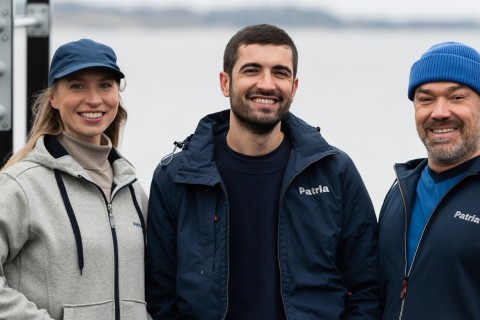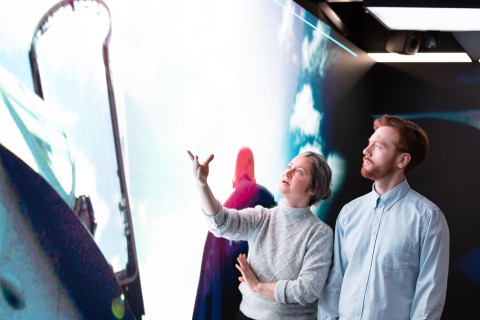
30.4.2020
Petriina Anttila works both for Patria as a flight instructor and for Finnair as an Airbus A330 co-pilot. She has achieved recognition in the field as the first woman in Finland to become a qualified flight examiner.
Text: Samppa Haapio Photos: Harri Hinkka
In summer 2019, Petriina Anttila’s name went down in Finnish aviation history when she became the first woman in Finland to become a qualified flight examiner.
“I have been doing practice examination flights with students for quite some time now, so when the course started, I decided to seize the opportunity. It provides yet another interesting aspect to my work. Throughout my career, I have sought personal development and gained additional qualifications through experience.”
Pilots regularly have their competence assessed, and it is the flight examiner’s task to test their practical skills in the sky. There are about 200 flight examiners in Finland, and their qualifications are administrated by the Finnish Transport and Communication Agency Traficom.
Workplace: Pirkkala and the world
Petriina Anttila trains pilots at Patria’s Pilot Training station at Tampere’s Pirkkala airport in Finland.
“A typical working day starts at eight a.m. with a morning briefing in which we go through things such as the weather and any special activities at the airport that might have an impact on training.”
In early 2020, Petriina and her colleagues and students were able to witness an example of such special activities at close quarters, as candidates for the HX programme replacing the current F/A-18 fighters with new ones were being tested in Pirkkala. This placed some restrictions on training activities.
Before every training flight, Petriina goes through the flight programme for the day and the targets for the training session, and also ensures that the student has the requisite theoretical knowledge for the programme. She has time for two or three flights per day, in between which feedback is given, and the instructor enters the assessments into the system.
Alongside her teaching work, Anttila also works as a co-pilot for Finnair, mainly on long-haul Asian routes. She does two or three flights per month, for which she has to drive from Pirkkala to Vantaa.
“In practice, I first receive my Finnair shifts and then decide how I want to make myself available as an instructor in my free time outside these hours.”
There are clear synergies to be obtained from this flexible system.
“We train Finnair pilots and, because I work there, we are also well prepared to teach the firm’s customs and procedures,” says Petriina.
Training bonus – Finnish weather conditions
Only commercial pilots are trained in Pirkkala. Recently, Pirkkala has been training pilots for other airlines in addition to Finnair, such as Norra and Air Astana.
“The employment rate for our pilot graduates is good, and training in Finland’s weather conditions is a bonus. The students get to experience a wide range of weather conditions from the outset, which provides an advantage in the job market.”
Twin-engine DA-42s are used for this training.
“A twin-engine aircraft can fly in much worse weather, which is why our training is geared towards airlines in particular: procedures relating to things such as IFR flights, situational awareness and handling workloads,” tells Petriina.
All the single-engine DA-40s except one have been flown to Cordoba, where Patria launched primary flight training in 2019.
“The single-engine aircraft are used to practice basic flying skills, while the twin-engines are used to practice skillsets.”
Pirkkala also has flight simulators: two DA-42s and one Airbus A320. The A320 simulator is used in the multi-crew cooperation course (MCC) and Multi-Crew Pilot License (MPL) programme. This combines basic training with type training for the Airbus A320.
Dream job: vet
Although Petriina recalls that her childhood dream was to become a vet, the skies have also fascinated her from a young age.
“When I was sixteen, I got really into hang gliding. My parents took me to airshows when I was a kid, and some of them featured hang gliders. That’s where it all began.”
“After graduating high school, I studied aircraft technology for a couple of years, but then transferred to an air traffic controller course. I completed my private pilot’s license with Patria Pilot Training while I was working as an air traffic controller at Pirkkala airport. I got my commercial pilot’s licence in 2006, but there was no work available at the time, so I started working as a flight instructor in 2008.”
Petriina’s first job was in Sweden, but she soon found herself back at Patria, initially as a freelancer, becoming a permanent employee when the school moved from Malmi to Pirkkala in 2017.
Petriina enjoys working at Patria.
“We have a great team, modern premises, and excellent new planes and simulators. Pilots are trained from start to finish, which offers instructors a broad variety of work and opportunities to develop in specific areas.”
From individual skills to overall management
Petriina has seen the industry develop a great deal during the course of her career.
“Pilot training used to focus on the mechanics of flying and mastering individual aircraft manoeuvres. These days, it’s more competency-based, that is, teaching knowledge, skills and attitudes that will help students in their future profession.”
Both pilots and instructors encounter the problems associated with sedentary work, which is why Petriina’s hobbies are physically active.
“I do all kinds of sports and outdoor exercise: hiking, skiing, stand up paddleboarding and motorcycling. And yoga! It’s an effective way of leaving the workday behind and keeping your body in good shape.”
What did you like about the article?
Thank you for your opinion! You can share the article on social media using the buttons below:






























